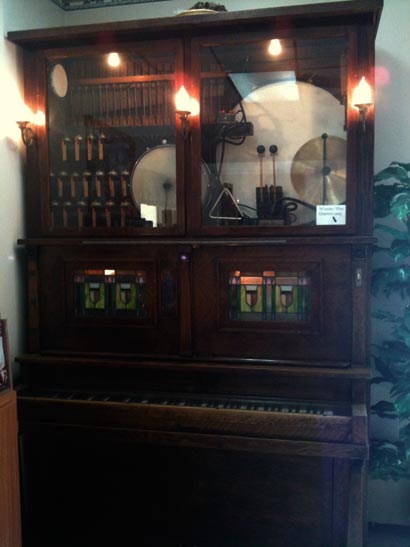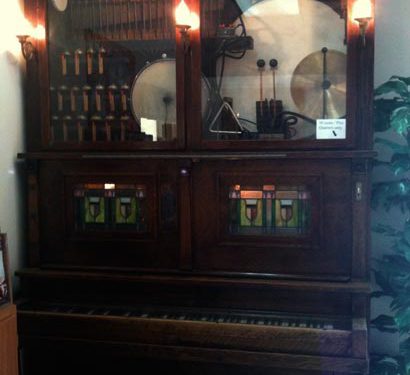
Sometimes you find enthralling historic music in the most unexpected places. Take for example this player piano made by the Western Electric Piano Company.
We were traveling back to the New York City area from a performance at Utz Terrace in Hanover, PA when we decided to make an unscheduled stop. At the time, we were traveling down Interstate 78 and saw a sign for Roadside America promoting a miniature village and railroad in Shartlesville, PA. We were actually ahead of schedule and a little bored with the drive so we said, “Let’s check it out.”
Having grown up near Niagara Falls, I’ve seen a great many disappointing tourist traps so I wasn’t expecting much. I figured it would be mildly entertaining at best. The miniature village itself was surprisingly cool and we actually spent a good deal of time there. However, after wandering around the gift shop we were astonished to find what we deemed to be the most amazing looking machine ever made. It was a working player piano complete with a percussion section hidden away in a corner near the restrooms.
A little white sign read, “50 cents 1 Play Quarters Only.” I dug through my pockets and found two quarters then proceeded to drop them in an old coin slot. Immediately following the drop of the first quarter the machine began to whirr and shortly there after, the music started. It was like stepping back into time as the mechanized sounds started to loft out of the vintage wood and glass.
This machine was way more than just your standard mechanized piano. Its rhythm section was complete with a bass drum, snare drum, cymbal, triangle, tambourine, 12 bells and a xylophone. These cool features earn the player piano a more accurate title of Orchestrion. The piano strings seemed to have two sounds. Those being the standard pianoforte sound and what I’ll call a saloon piano sound for lack of a better term.

Upon a closer inspection of the piano we noticed a maker’s mark saying Western Electric Piano Co., Chicago Ill. Some quick research uncovered the Western Electric Piano Co. as being secretly owned by the J.P. Seeburg Piano Co. The Western Electric Piano Co. name was really a marketing ploy to inspire competition between retailers. Surprisingly Seeburg actually went so far as to patent some of the mechanisms in these models to keep retailers and the public from realizing that they were really being produced by the same company.
The Western Electric pianos were only produced from 1924 until 1928 and were generally considered to be of good quality. The most popular models produced by the company were a cabinet style, which did not feature a functioning keyboard. The orchestrion models like the one we saw were not as widely purchased, and most likely cost prohibitive.
Most of Western Electric’s models used the standard “A” sized piano rolls, which featured ten songs. We only listened to two of the tunes on the mechanical masterpiece, and both were unfamiliar to us. The Orchestrion at Miniature Village had been retrofitted to accept quarters. In the instrument’s heyday it would have only cost 1 nickel per play. Player pianos actually are often times called nickelodeons due to the association of their cost. The popularity of nickelodeons started to falter in the 1920s as a result of the emergence of broadcast radio. Suddenly people weren’t required to pay for their entertainment and as a result the player piano’s weren’t really needed anymore.
It’s interesting to consider the parallels between the advent of the radio and the current evolution of the internet. Today the music industry is once again struggling to remain viable as MP3 files are being freely traded online. Technology may come and go while tastes and styles change, but the importance of trained, adaptable and soulful live musicians has remained a constant since the first caveman kept a beat by banging two stones together.
Tags: “A” sized piano roll, bass drum, bells, broadcast radio, Chicago Ill, cymbal, Hanover, historic music, Interstate 78, J.P. Seeburg Piano Co., Miniature village, MP3pianoforte, Niagara Falls, nickelodeon, Orchestrion, PA, Piano, Player Piano, saloon music, Shartlesville, snare drum, tabourine, triangle, Utz Terrace, Western Electric Piano Co., xylophone
Posted in General Music History, Instruments, Personal Memoir | 3 Comments »

